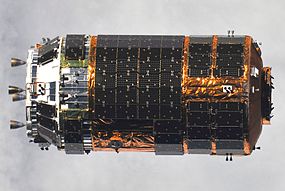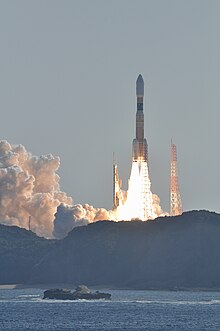From Wikipedia, the free encyclopedia
 |
|
|---|---|
| Description | |
| Role: | Unmanned spacecraft intended to resupply the Kibō Japanese Experiment Module on the International Space Station and, if necessary, the rest of the station. |
| Crew: | Unmanned |
| Dimensions | |
| Height: | ~9.8 m (including thrusters)[1] |
| Diameter: | 4.4 m[1] |
| Spacecraft Mass: | 10,500 kg[1] |
| Total Launch Payload: | 6,000 kg[2] |
| Pressurized Payload: | 5,200 kg[2] |
| Unpressurized Payload: | 1,500 kg[2] |
| Return Payload: | None[3] |
| Mass at launch: | 16.5 ton[2] |
| Pressurized Volume: | 14 m3[4] |
| Performance | |
| Endurance: | Solo flight about 100 hours, stand-by more than a week, docked with the ISS about 30 days[1] |
| Apogee: | 460 km[1] |
| Perigee: | 350 km[1] |
| Inclination: | 51.6 degrees[1] |
Design
The HTV is about 9.8 m long (including maneuvering thrusters at one end) and 4.4 m in diameter. Total mass is 10.5 tonnes, with a 6,000 kilograms (13,000 lb) payload.[1] The HTV are comparable in function to the Russian Progress, European ATV, commercial Dragon, and commercial Cygnus spacecraft, all of which bring or are planned to bring supplies to the ISS. Like the ATV, the HTV carries more than twice the payload of the Progress, but is launched less than half as often. Unlike Progress capsules and ATVs, which dock automatically, HTVs and American commercial crafts approach the ISS in stages, and are signaled by ISS crew or ground control to continue from one holding point to the next. Once they reach their closest parking orbit to the ISS, crew grip them using the robotic arm Canadarm2 and berth them to an open berthing port on the Harmony module.[7]The HTV has an external payload bay which is accessed by robotic arm after it has been berthed to the ISS. New payloads can be moved directly from the HTV to Kibō's exposed facility. Internally, it has eight International Standard Payload Racks (ISPRs) in total which can be unloaded by the crew in a shirt-sleeve environment. After the retirement of NASA's Space Shuttle in 2011, HTVs became the only spacecraft capable of transporting ISPRs to the ISS, until that capability was expanded with the introduction of the SpaceX Dragon in 2012.
To control the HTV's attitude and to perform the orbital maneuvers such as rendezvous and re-entry, the craft has four 500 N class main thrusters and twenty-eight 110 N class attitude control thrusters. Both use bipropellant, namely monomethylhydrazine (MMH) as fuel and mixed oxides of nitrogen (MON3) as oxidizer.[9] HTV-1, -2, and -4 use Aerojet's 110 N R-1E, Space Shuttle's vernier engine, and the 500 N based on the Apollo spacecraft's R-4D.[9] Later HTVs use 500 N class HBT-5 thrusters and 120 N class HBT-1 thrusters made by Japanese manufacturer IHI Aerospace Co., Ltd.[10] The HTV carries about 2400 kg of propellant in four tanks.[9]
After the unloading process is completed, the HTV will be loaded with waste and undocked. The vehicle will then deorbit and be destroyed during reentry, the debris falling into the Pacific Ocean.[3]
HTV-R
As of 2010, JAXA is planning to add a return capsule option. HTV's Pressurized Cargo is replaced by a reentry module capable of returning 1.6 tonne cargo from ISS to Earth.[11][12] It is expected to be launched by 2018.[13][not in citation given]Further, it is expected to be followed on by 2022 by capsules which accommodate a crew of three and carry up to 880 pounds (400 kilograms) of cargo.[14]





No comments:
Post a Comment